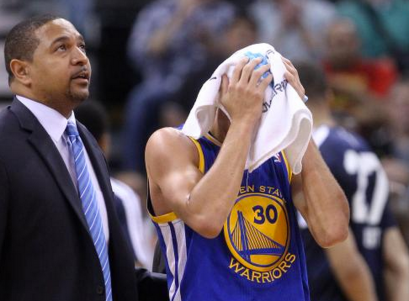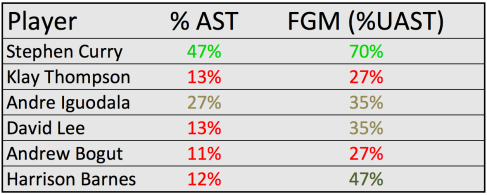
Source: Rick Bowmer/Associated Press
In a previous post, I looked at the secret sauce behind Golden State’s win-loss record. Using a basic statistical technique, I found that their strongest signal for a loss was having 20 or fewer assists. In isolation, this does not provide much value to the Warriors. However, when I considered the interrelatedness of assists, playmaking, and shot selection, everything started to come together…
Shortage of Playmakers
There are two main aspects of being a playmaker. Either (a) a player enables a teammate to score or (b) a player creates his own shot. Assists are a good proxy for the former and percentage of unassisted field goals made for the latter. It follows that a game that results in lower assists could be indicative of: poor shooting by non-playmakers and/or poor passing by playmakers. This is why assists are generally more valuable to say, the Golden State Warriors, than they are to teams like the Indiana Pacers (who have many players who can create their own shots). The double-whammy effect of low assists is a large weakness for the Warriors.
Here is a summary table that shows the percentage of assists a given player is responsible for when he is on the court as well as the percentage of unassisted field goals made. (Please note: the values in the ‘% AST’ column will not add up to 100% because the same players are not all on the court at the same time.)

Curry is accountable for roughly half of the assists that occur when he is on the court. Iggy contributes less than a third of the assists, and there is a long tail of players in the main rotation who are good for a few assists each. In addition to making plays for his teammates, Curry also creates his own shot a majority of the time. In fact, 70% of the field goals he makes are unassisted. Iguodala and Lee are also fairly decent at creating their own shot opportunities. In fact, Lee has been a huge asset (sometimes taken for granted) to the team, given the shortage of shot creators.
Though Barnes has a relatively high percentage of unassisted field goals made this season, he is an interesting case. Last year, when he was part of the starting rotation, only 37% of his made shots were unassisted. Now that he is coming off the bench with the addition of Iggy, Barnes has had to rely on Toney Douglas’ playmaking abilities (or lack thereof). Given his low assist contribution, Barnes has not been particularly good at setting his teammates up to score. This poses a significant limitation on the effectiveness of the Warriors’ second unit. With Wednesday’s trade, the current state of affairs will hopefully improve. Since there are a lot of moving parts, it may be effective for Mark Jackson emphasize true rotations rather than relying on a “second unit” altogether.
Klay Thompson is particularly bad at both getting his teammates involved and creating his own shot. In fact, only 6% of the three-pointers that Klay has made have been unassisted. Given how high volume of a long distance shooter Klay is, this poses some obvious strain to the Warriors offense. For some context of how Klay compares to the rest of the league, here are how other successful shooting guards are faring this season:

It is pretty clear from these summary statistics that Klay Thompson does not stack up against the better shooting guards in the league when it comes to overall playmaking ability. This provides extra pressure for Curry—the primary ball handler. It also puts the team at great risk in case of an injury to Iguodala, Curry, or even Lee. When it comes down to it, the dependence on these three players to make plays limits the offensive versatility of the overall team.
In order to minimize this risk, a few key things need to happen:
1. Klay Thompson needs to get better at creating his own shot. Whether this means splitting the Splash Brothers in some rotations or having Thompson come off the bench against subpar teams, Mark Jackson will have his work cut out for him. If Thompson can improve this aspect of his game, it could make the Warriors’ backcourt unstoppable on the offensive end. He is already very good at moving without the ball and has a lot of potential.
2. There needs to be an effective playmaker in the second unit. Though Harrison Barnes has become better at creating his own shot this season, the bench lacks a true ball handler who can get his teammates involved. As a result, promising players like Draymond Green have been woefully underperforming. The addition of Jordan Crawford will help with this, but the Warriors are going to need to put together a more complete rotation involving talented bench players.
Shot Selection
The Warriors are a strong scoring team, consisting of some of the best shooters in the league. Where do all these points come from and what can we learn from this? Using Player Tracking data from SportsVU, courtesy of the NBA, I split the scoring up into three general areas: drives, catch-and-shoot, and pull up.
Drives
It is not surprising that Steph drives a lot, but it is important to note how infrequently Klay does. Attacking the rim more often could be a way for Klay to create more of his own shots, especially when he is not shooting well from beyond the arc. Right now, the Warriors are very dependent on Klay Thompson’s long range game. Thompson shoots 49% from beyond the arc in Warriors victories versus 30% during losses. What is interesting is that he averages roughly the same number of three point attempts in both wins and losses.
Catch-and-Shoot

Catch-and-shoot jumpers include all jump shots greater than 10 feet from the basket where the player possessed the ball for under 2 seconds and did not dribble.
This type of shot is Klay’s favorite—it accounts for almost half of his overall points on average. Given that it requires another teammate to make this play, it is not surprising that Thompson gravitates towards this shot. When he is having a great shooting night, it is fun to watch. However, when Klay is struggling (as he was against the Spurs on December 19th, shooting just 1-for-7 from beyond the arc), the rest of his game just disintegrates.
Iggy is also very effective in catch-and-shoot opportunities. In fact, of players who averaged at least 20 minutes and one catch-and-shoot 3-point opportunity a game, Andre Iguodala has the highest catch-and-shoot 3FG% in the league!
Pull Up

Pull up shots include all jump shots greater than 10 feet from the basket where the player took at least 1 dribble prior to shooting.
Klay’s poor performance from beyond the arc on pull up shots is very much related to his inability to create his own shot. As a benchmark, his overall 3FG% is 41% (mostly consisting of catch-and-shoots). On the other hand, this shot type accounts for roughly 44% of Steph’s points!
There is something really special happening in Oakland, and the rest of the world is starting to take notice. Could the Warriors win a championship this year? If they address some of these weaknesses, then maybe. Don’t tell me you haven’t seen crazier things happen in the world of sports, especially with so much raw talent on one team…



